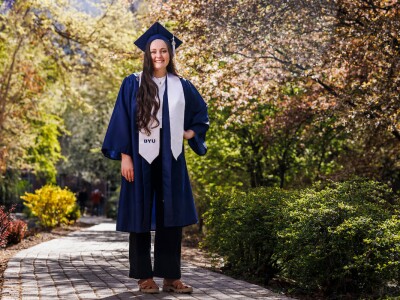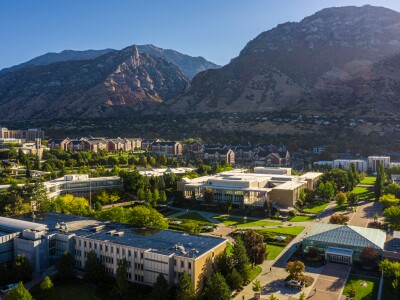In a corner lab of the BYU Crabtree Technology Building, there is a constant hum as five machines zip back and forth. Hour by hour and layer by layer, a group of 3D printers are churning out protective face masks.
A few days prior, Provo City Police and Provo City Fire sent out a call for help. As is the case for many first responders across the nation, the coronavirus pandemic has caused a shortage of personal protective equipment (PPE).
As is often the case amid crisis, necessity became the mother of invention.
Provo City Police tracked down a blueprint for a reusable respirator mask that could be created on a 3D printer and asked anyone with a 3D printer to power up their machines.
“When we got the call from the police, we jumped on it and made it our top priority,” said Therin Garrett, operations manager of the BYU Prototyping Manufacturing Lab.
And the engineering department isn't alone in its efforts – BYU's Physics and Astronomy department has another printer churning out eight masks per day, and several students have donated their personal machines to the cause, producing one mask every eight hours from their apartment bedrooms.
“We all have a responsibility to help where we can," said Michael Jensen, dean of the Ira A. Fulton College of Engineering. "To be able to dedicate our resources and skills to help, even in a small way, those on the front lines who are navigating this crisis gives additional meaning to what we do.”
Designed by Montana doctor Dusty Richardson, the purpose of this specific mask is two-fold:
- Reusable: Each mask is customizable to the wearer’s face (similar to a sports mouthguard that you’d mold using hot water) and can be sterilized for reuse day after day.
- Stretching Resources: The mask isn’t a replacement for the scarce N95 masks, but first responders can cut up one N95 mask to fit over the filter of the 3D printed mask. A single N95 mask can supply up to five 3D printed respirator masks.
The cost of materials per mask is a small $1.38, but as with most 3D printing, Garrett has to balance speed with quality. It takes roughly three hours for one printer to make a single mask, anything faster and the mask will have defects. Some of BYU’s printers can create three masks at once in about nine hours.
The 3D printed masks are not FDA approved replacements for true N95 medical-grade masks, and will require first responders to do some training on the proper application of the mask.
This particular job hits close to home for Garrett. For the last four years, Garrett has served as a volunteer Firefighter and EMT for Mapleton City. Each day after work at BYU he gets to see firsthand just how scarce protective resources are for first responders.
“I was taking patients to the ER last night, dressed in full protective gear,” Garrett said. “It’s exciting to see the engineering side and the first responder side of this come together. It gives me hope that this might actually work to help save resources and even lives.”
Garrett also cautioned that the 3D printed masks are not FDA approved replacements for true N95 medical-grade masks. The 3D printed masks will require first responders to do some training on the proper application of the mast.
Student lab manager Jason Redding is from the greater Seattle area and his parents still live in a suburb that saw some of the country's first cases of community spread of COVID-19. Redding said he's grateful for any chance to contribute to slow the spread of the disease.
Anyone who would like to be involved in the project can visit this link to find opportunities and resources to get started.








